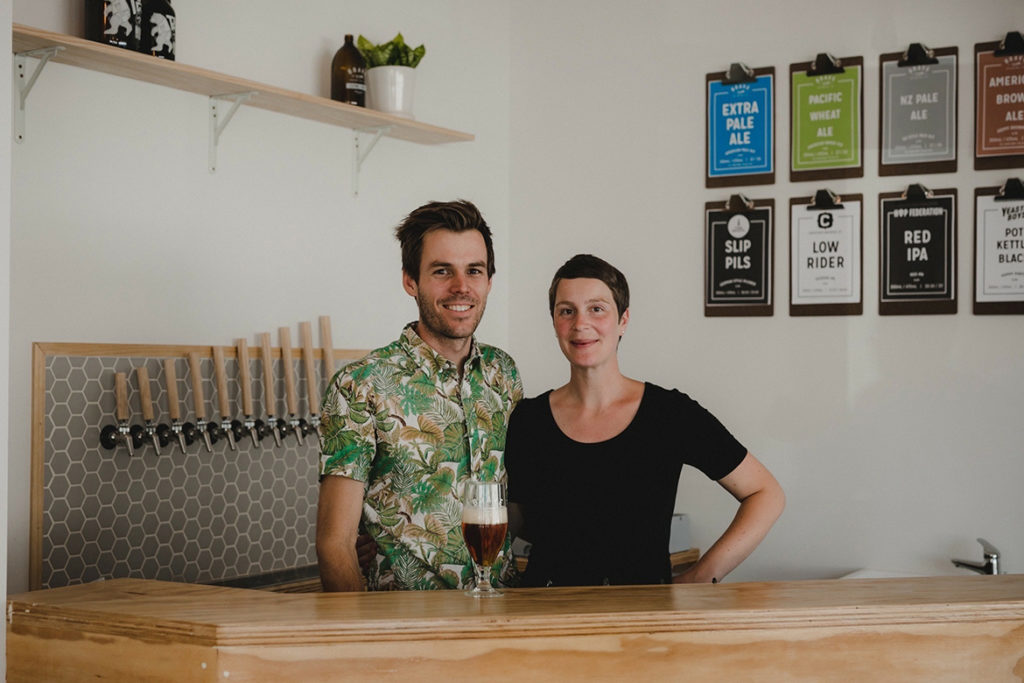It took a while to take off, but the Hawke’s Bay craft brewing industry is now going from strength to strength as demand grows for fresh, local beers.
There’s plenty of fizz in Hawke’s Bay’s growing craft beer scene at the moment – just ask Giant Brewing’s Chris Ormond (pictured above) and Matt Smith of Brave.
Chris is shifting Giant’s production facility from the back corner of the Origin Earth cheese factory on the outskirts of Havelock North to its own space in the heart of the village. While Matt has moved Brave from his garage to a brewing facility in Hastings, which doubles as a off-licence and bar.
Giant’s move to a larger, more prominent site is just one example of the growth that’s evident as Hawke’s Bay’s craft beer industry continues to go from strength to strength.
The new Donnelly Street location – expected to be up and running by the end of the year – will give Chris more room to brew and also paves the way for plans to sell his beers directly to the public.
“Our bread and butter is wholesaling to mainly local customers. We’ll continue to do
that but next year, we’ll look to add an off- license so we can also do flagon filling and bottle sales,” he says.
It’s almost three years since Chris, a journalist by trade and long-time home brew enthusiast, launched the Giant label with two hands-off partners, including brother Tom who runs Havelock North’s Hawthorne Coffee.
Since those early days, the Giant Brewing label has popped up in a growing number of bars, cafes and shops across Hawke’s Bay and as far afield as Auckland and Blenheim.
The growth of the business has seen it morph from a part-time interest to a full- time gig for Chris this year and Giant’s success reflects premium beer’s growing popularity in the region.
“In the last three years the Hawke’s Bay craft beer scene has really developed. It’s come ahead in leaps and bounds. When we started there wasn’t a huge amount of craft beer in a lot of the boutique cafes and restaurants,” Chris says.
“I talked to quite a few of them and most were keen to get some Giants in the fridge
and they showed a lot of support, and a lot of the ones we started off with are still buying the beer on a weekly or fortnightly basis and it’s gone down really well.”
Chris says 90 per cent of Giant’s business is from repeat customers who re-order on a weekly or fortnightly basis and he’s keen to keep it as a “boutique” operation.
“World domination is certainly not on the agenda. We just want to really get the Hawke’s Bay side of things going as well as we can, get off-license sales up and running, and maintain the good out-of-town customers we’ve got.”
Giant’s steady growth off the back of the local beer market demanding more sophistication and variety is echoed by developments across other Hawke’s Bay players in the craft beer industry, which includes Fat Monk Brewery, Roosters Brew House, Hawke’s Bay Independent Brewery, Zeelandt Brewing, Godsown Brewery and Napier Brewing Company.
Brave – a hobby that got out of control
Matt, who founded Hastings-based Brave Brewing with wife Gemma three years ago, says he’s been blown away by the success of what he calls “a hobby that got out of control”.

Matt & Gemma of Brave
“We started in my home garage, alongside a full-time day job, and just chipped away at it
slowly. Without taking on too much risk and debt at any one time, we upgraded in small steps when we needed to.”
Now Brave has a brewery, cellar door and tasting room at a Warren Street space it shares with Carr’s Kitchen and is brewing its full capacity of 1,000 litres of beer a week.
That will change early next year when a new brewing kit arrives and Matt will be able to quadruple the size of the batch he can brew at any one time.
Matt was stoked to pick up seven medals and the trophy for Best in Class in the US Ale category at this year’s Brewers Guild of NZ Awards, announced in October.
“To be recognised alongside some of the really good, well-established breweries who have a bit of a team behind them, and rostered brewing shifts and fancy equipment and all that sort of thing. It’s pretty cool to be in the same sort of league as them.”
Like Chris, Matt says his future plans are focused on primarily serving the local region.
“I’d like to keep things reasonably small. I’d like to see us as a Hawke’s Bay brewer in the first instance – doing some keg and bottle sales outside Hawke’s Bay but keeping it at a nice manageable level where it’s a lifestyle as much as a business,” he says.
“I don’t have any aspirations for us to become a big million-litre-a-year type of place. I’m quite happy being a smaller player.”
